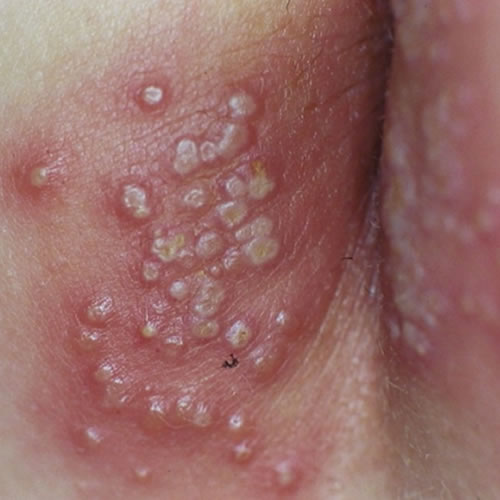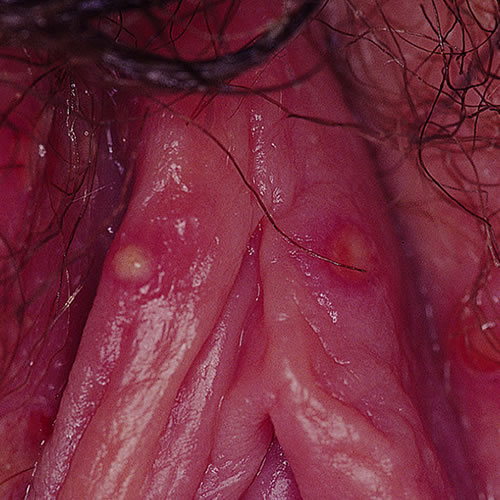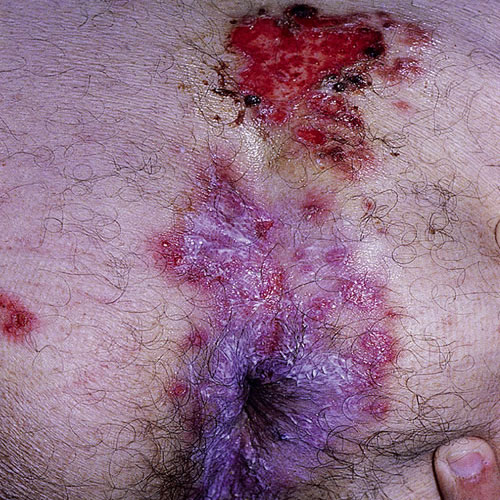Introduction
Herpes simplex virus1 (HSV) of the vulvar area is usually sexually transmitted. It is characterized by recurrent outbreaks of itching and pain, grouped vesicles and erosions. It is however, possible to have either primary or recurrent herpes without an outbreak of lesions. Synonyms for HSV include herpes genitalis, herpes progenitalis, and cold sore.
Epidemiology
HSV-1 and HSV-2 are common infections worldwide; in the United States alone at least 50 million persons have genital herpes. 2 3 As an additional concern, genital HSV is frequently under-recognized because infection is often subclinical; 4 in a population-based cross-sectional survey of adults living in New York City, nearly 28 percent were infected with HSV-2 and 88 percent had no knowledge that they had HSV. 5 Prior infection with HSV-1 also leads to a three-fold increase in asymptomatic HSV-2 infection.6
Etiology
Although HSV-2 remains the causative agent for the preponderance of confirmed genital herpes infections, HSV-1 is associated with an increasing proportion of cases.7 8 Herpes Simplex is most common in sexually active adults. Transmission is by person-to-person contact, with an incubation period of 2 to 20 days (with an average of 7 days).
Symptoms and clinical features
The clinical manifestations of genital HSV vary widely depending upon whether the infection is primary, non-primary, or recurrent.
Herpes simplex manifests in three different ways:
Primary Herpes Simplex.
There may be a history of recent exposure, usually sexual, to a person with cold sores (which almost always culture HSV type 1). Most HSV infections are transmitted during periods of asymptomatic viral shedding. Most infected individuals do not know they are infected or infectious.
Classic primary herpes vulvitis is not commonly seen but presents as follows: initial paresthesia that may include itching as the vulva becomes very red and swollen within 2 to 7 days of exposure. Fever, malaise, headache, and myalgia may develop for another 2 to 3 days. Extensive groups of vesicles appear, rapidly become pustular, and break open, leaving very tender erosions that last for 14 to 16 days. Lesser involvement with minimal vesicle formation may not be detected by the woman. Primary herpes simplex is usually on the labia, perineum, vagina, and cervix and may involve the urethra, bladder, and anus. Discomfort may vary from irritation to deep boring pain that is moderate to severe. When the pain is severe, there is difficulty with urination. Catheterization may be necessary.

After the initial outbreak, the virus becomes dormant in neuronal cells in ganglia.
More often, the primary case is subclinical or mistaken by the patient for a yeast infection, although eroded vesicles can be quite painful. In recurrent infections (much more common than primary infections) tingling, itching, and burning usually occur before the onset of vesiculation, and the symptoms are usually less severe and of shorter duration than in primary outbreaks.
Recurrent Herpes Simplex.
Patients with primary genital HSV need to be counseled that recurrence is expected. The frequency of recurrence depends on the severity and duration of the initial episode, the infecting serotype, and the host. The lesions are much less extensive and of shorter duration than those of primary herpes simplex. There may be only mild swelling and a few vesicles that become pustules and erosions.

They recur in about the same area each time and may be manifested only with erythema and tingling or sine eruptione (without blisters). Linear fissures may also occur. These patients complain of cyclic episodes of burning pain and discomfort but no “rash.” Recurrent infection is usually labial. There may be lesions on the buttocks, as well. If the patient never experienced the classical primary outbreak, a recurrent outbreak may be seen by her as primary. Since the latency period between primary and recurrent outbreak may take years, it may be difficult for her to know the original source of infection. Herpes Simplex Virus type 2 recurs six times more commonly than HSV 1. About 95% of primary HSV 2 will recur within two months. Women experience recurrences less commonly than men do.
Immunosuppressed Herpes Simplex.
These patients often develop areas of ulceration, papules, verrucous lesions, or vegetating plaques that extend peripherally and may be necrotic, painful, and indolent.

Note: With any of these HSV infections, the inguinal nodes can be swollen and tender.
Postherpetic neuralgia (PHN)
The lesions of herpes simplex are tender and painful. Unlike herpes zoster, regression of pain with HSV usually occurs as the lesions resolve. Postherpetic neuralgia with ongoing pain for weeks months or years is reported with herpes zoster. 9 (Atlas Herpes zoster). Description of PHN with HSV is found in case studies10. Innoculation of mice with HSV 1 causes herpes zoster-like skin lesions and tactile allodynia and mechanical hyerpalgesia with pain related responses long after the lesion heals. 11 12 We believe that we have seen several cases of postherpetic neuralgia in women with HSV 1 and 2. These cases have responded over time intervals varying from weeks to years to gabapentin and pregabalin.
Diagnosis
Diagnosis is initially made clinically and confirmed with a viral culture. The overall sensitivity of viral culture is only 50%. 13 A negative culture does not therefore rule out herpes. The diagnostic yield of culture is highest in the early stages of disease, when lesions are typically vesicular, and declines rapidly as the lesions begin to heal. 14 Yield may be increased by culturing the vagina and cervix, where viral shedding may occur, with the lesions. The pattern of HSV most often missed is the recurrent episodes of vulvar burning with cyclic episodes of itching and burning but no skin eruption.
Viral culture remains the standard diagnostic method for isolating HSV, but real-time HSV PCR assays have emerged as a more sensitive method to confirm HSV infection in clinical specimens obtained from genital ulcers and mucocutaneous sites.15 PCR is particularly useful for the detection of asymptomatic HSV shedding.16
Herpes serology may be helpful in ascertaining whether a patient’s vulvovaginal complaints could be herpes, even if a lesion is not present at the time of the patient’s visit. Type specific antibodies to HSV develop during the first several weeks after infection and persist indefinitely.17 Serology should be obtained six weeks after the initial outbreak. The availability of type-specific antibody testing enables specific identification of HSV 1 or HSV 2, and has facilitated greater accuracy in epidemiologic surveys.
Pathology/Laboratory Findings
Although usually clinical, the diagnosis is confirmed with a viral culture, PCR, and/or serology. Biopsy, while helpful, does not distinguish between herpes simplex and herpes zoster.
Differential diagnosis
Differential diagnosis includes chancroid, syphilis, trauma, pemphigus, aphthous ulcers, herpes zoster, Behçet disease, granuloma inguinale, and lymphogranuloma venereum. Herpes zoster is more likely to be unilateral and in a dermatomal pattern.
Treatment/management
Education and emotional support are essential with written materials, brochures and contact information. Women are often distraught with confusion and disbelief with the diagnosis.
| National Herpes Hotline: Provides herpes information and referrals to clinics or support groups | |
| (919) 361-8488 9 a.m. – 7 p.m EST, Monday- Friday | For Written Materials: (800) 230-6039 Recorded Information: (800) 653-4325 |
General supportive care for the acute swollen vulva consists of the following:
- Warm soaks in a sitz bath or cool compresses 2 to 3 times a day.
- A bland barrier ointment — petrolatum, zinc oxide–can also be used to promote healing.
- For pain, use lidocaine-prilocaine cream (EMLA) applied in a thick layer under plastic wrap for 20 minutes for local anesthesia as needed.
- Catheterization and sedation may be necessary.
Specific treatment for primary HSV includes:
- Valacyclovir (Valtrex) 1g orally twice a day x 7 days
- Famciclovir (Famvir) 250 mg orally three x a day x 7 days
- Acyclovir (Zovirax) 400 mg orally three times a day or 200 mg orally five times per day.
- Any of the three agents can be used since they are equally effective. Treatment significantly decreases the duration and severity of disease The usual duration of treatment is 7-10 days.
Specific treatment for severe mucocutaneous HSV includes:
- Valacyclovir (Valtrex) 1 g orally twice a day x 5 days
- Famciclovir (Famvir) 500 mg orally twice a day x 5 days
- Acyclovir (Zovirax) 400 mg orally at 7 and 11 AM and 3, 7, and 11 PM x 7 days
If systemic involvement is suspected, administer acyclovir (Zovirax) 5 mg/kg IV q8h for 5 to 7 days, assuming normal renal function.
Specific treatment for episodic recurrent HSV includes:
- Valacyclovir (Valtrex) 500 mg orally twice a day x 3 days or 1 gram orally for five days
- Famciclovir (Famvir) 1000mg orally twice a day x 1 day or 125 mg twice daily for 5 days
- Acyclovir (Zovirax) 800 mg orally three times a day x 3 days or 800 mg orally twice daily for 5 days
Suppressive treatment for recurrent HSV (> 6 outbreaks annually) includes:
- Acyclovir: 400 mg twice daily
- Famciclovir: 250 mg PO two times daily
- Valacyclovir: 500 mg once daily OR 1 gram orally once a day
- If valacyclovir is used, the 1 gram dose is recommended among patients with >10 recurrences annually [37].
- Antiviral therapy effectively suppresses HSV reactivation and decreases shedding in patients with frequent recurrences. Although suppressive therapy has been given for as long as six years, the use of suppressive antiviral medications should be re-evaluated periodically, since the benefits and risks beyond six years have not yet been determined. 18
Specific treatment for immunocompromised HSV includes:
- Acyclovir (Zovirax) 5 mg/kg IV q8h x 5 to 7 days
- Foscarnet (Foscavir) 40 mg/kg IV q8h until resolution. Foscarnet is used only if there is intolerance to acyclovir, famciclovir, or valacyclovir and the safety of this drug in pregnancy is not established.
Specific treatment for asymptomatic viral shedding is given indefinitely. The following drugs reduce viral shedding by 92%:
- Valacyclovir (Valtrex) 1 g orally daily
- Acyclovir (Zovirax) 400 mg orally twice a day
- Famciclovir (Famvir) 250 mg orally twice a day
No treatment for HSV is a “cure” or prevents asymptomatic shedding completely. The response to treatment depends on the patient’s individual immunity.
In primary herpes simplex, rule out other STDs. Herpes patients often need a lot of support and counseling. Education with up-to-date information is very important. Circumcision and condom use afford some protection against transmission. For more on herpes simplex, please access the CDC website: http://www.cdc.gov/std/Herpes/default.htm.
References
- Fisher BK, Margesson, LJ. Genital Skin Disorders: Diagnosis and Treatment. Mosby, Inc., 1998.131-133.
- http://www.cdc.gov/std/treatment/2010/default.htm
- Xu F, Sternberg MR, Kottiri BJ, et al. Trends in herpes simplex virus type 1 and type 2 seroprevalence in the United States. JAMA. 2006; 296:964.
- Benedetti J, Corey L, Ashley R. Recurrence rates in genital herpes after symptomatic first-episode infection. Ann Intern Med. 1994; 121:847.
- Schillinger JA, McKinney CM, Garg R, et al. Seroprevalence of herpes simplex virus type 2 and characteristics associated with undiagnosed infection: New York City, 2004. Sex Transm Dis. 2008; 35:599.
- Langenberg AG, Corey L, Ashley RL, et al. A prospective study of new infections with herpes simplex virus type 1 and type 2. Chiron HSV Vaccine Study Group. N Engl J Med. 1999; 341:1432.
- Ross JD, Smith IW, Elton RA. The epidemiology of herpes simplex types 1 and 2 infection of the genital tract in Edinburgh 1978-1991. Genitourin Med. 1993; 69:381.
- Roberts CM, Pfister JR, Spear SJ. Increasing proportion of herpes simplex virus type 1 as a cause of genital herpes infection in college students. Sex Transm Dis. 2003; 30:797.
- Oxman MN. Herpes zoster pathogenesis and cell mediated immunity and immunosenescence. J Am Osteopath Assoc. 2009; 109(6 suppl):S13-17.
- Gonzales GR. Postherpes simplex type 1 neuralgia simulating postherpteic heuralgia. J Pain symptom Manage. 1992; 7(5):320-323.
- Kuraishi Y, Takasaki I, Nojima H, et al. Effects of the suppression of acute herpetic pain by gabapentin and amitriptyline on the incidence of delayed postherpetic pain in mice. Life Sci. 2004; 74(21):2619-2626.
- Takasaki IM Nojima H, Shiraki K, et al. Involvement of cyclooxygenase-2 and EP3 prostaglandin receptor in acute herpetic but not postherpetic pain in mice. Neuropharmacology. 2005; 49(3):283-292.
- Schomogyi M, Wald A, Corey L. Herpes simplex virus-2 infection. An emerging disease? Infect Dis Clin North Am. 1998;12:47.
- Moseley RC, Corey L, Benjamin D, et al. Comparison of viral isolation, direct immunofluorescence, and indirect immunoperoxidase techniques for detection of genital herpes simplex virus infection. J Clin Microbiol. 1981; 13:913.
- Strick LB, Wald A. Diagnostics for herpes simplex virus: is PCR the new gold standard? Mol Diagn Ther. 2006; 10:17.
- Cone RW, Hobson AC, Palmer J, et al. Extended duration of herpes simplex virus DNA in genital lesions detected by the polymerase chain reaction. J Infect Dis. 1991; 164:757.
- Centers for Disease Control and Prevention, Workowski KA, Berman SM. Sexually transmitted diseases treatment guidelines, 2006. MMWR Recomm Rep. 2006; 55:1.
- Reitano M, Tyring S, Lang W, et al. Valaciclovir for the suppression of recurrent genital herpes simplex virus infection: a large-scale dose range-finding study. International Valaciclovir HSV Study Group. J Infect Dis. 1998; 178:603.